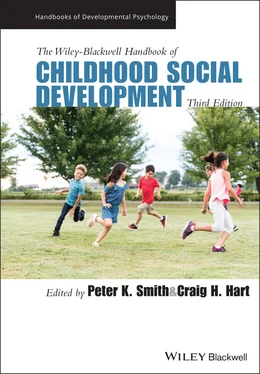CHAPTER ONE Conceptual and Empirical Precursors of Contemporary Social Development Research
Gary W. Ladd
The aim of this chapter is to consider how conceptual and investigative trends over the past half‐century (i.e., 1970s to 2020s; the “modern era”; Collins, 2011) shaped the theoretical and investigative agendas that drive contemporary research on social development. This historical analysis begins by briefly examining some of the ideological and empirical foundations of the modern era. It then proceeds to identify the dominant aims and foci of social development discipline during the past half‐century and trace the major research trends and substantive developments that transpired during that epoch. Of particular interest are research agendas that supersede individual substantive areas and thereby exemplify the overarching purposes of the larger scientific enterprise. Finally, this analysis traces some of the conceptual and empirical forces that transformed the discipline, including shifts in explanatory foci and frameworks, the influx of sociocultural issues and crises, and the introduction of novel research methods and analytic strategies.
Foundations of the Modern Era
The ideological underpinnings of the modern era can be traced to an intellectual awakening that originated during the 1800s and continued into the mid‐1900s (the emergent and middle periods; Collins, 2011). Interest in child socialization and development grew out of the enlightened humanitarian values and novel theoretical speculations that were expressed in the writings of philosophers, psychologists, educators, and physicians during the mid‐ to late 1800s. These innovative ideas challenged prevailing perspectives on a range of sociocultural and scientific issues including the origins of morality, the determinants of crime and juvenile delinquency, the causes of mental illness, and the value of education for children.
By the turn of 20th the century, these ideological forces inspired new ways of thinking about childrearing and development. Critical in this shift was the view that children’s development was driven not only by forces acting inside the child (e.g., the child’s nature), but also by forces outside the child, such as the socializing influences of families, peers, and cultures.
In the scientific community, the role of socialization and children’s social experience figured prominently in emerging theory and research on normal and abnormal development. Early examples include G. Stanley Hall’s (1844–1924) investigations of school children’s interests and experiences (White, 1994), John B. Watson’s (1878–1958) contention that learning drives development (Watson, 1913), and James Mark Baldwin’s (1861–1934) assertions that the child’s social environment, and the child’s reactions to this milieu, were essential and interrelated components of development (Cairns, 1994). During the early‐ to mid‐1900s, theorists such as Sigmund Freud, Erik Erikson, George Herbert Mead, Jean Piaget, and Lev Vygotsky contended that, among other influences, children’s development was affected by their experiences with adult caregivers and peers.
Freud (1856–1939) stressed the importance of early experience and theorized that conflicts between the child’s biological drives and rearing experiences (i.e., progressively across distinct psychosexual stages) shaped personality development. He also saw early parent–child play as a context that influenced children’s sense of self and shaped their emotional ties with caregivers (via brief separations and feelings of loss; Emde, 1994). In proposing the concept of the “looking glass self,” Mead (1863–1931) asserted that the individual’s self‐concept was based on the reactions they received from others (Mead, 1913). Erikson (1902–1994), a student of Freud’s, recognized the importance of parents and peers in children’s identity formation by arguing that relations with socializers could enhance or undermine a child’s sense of interpersonal trust, self‐worth, and social competence (Erikson, 1950).
Piaget (1896–1980) articulated a constructivist perspective in which organismic growth coupled with formative experiences – particularly conflicts with peers and other socializers – propelled not only children’s intellectual development but also their moral development (Beilin, 1994). The Russian psychologist Vygotsky (1896–1934), a contemporary of Piaget’s who died much younger than him, emphasized the social context of learning (Vygotsky, 1978). His concept of the zone of proximal development proved especially influential and was taken up later by Bruner in his concept of scaffolding . Many other scientists contributed to this paradigmatic shift and readers are encouraged to consult more detailed accounts of the intellectual currents and contributors that foreshadowed the modern era (e.g., Collins, 2011; Parke et al., 1994; Sears, 1975).
These early forerunners and their intellectual and empirical contributions created a foundation for social development as a discipline. Considered next are the theoretical and empirical elaborations and innovations that were erected upon this foundation during the following half‐century, or the modern era.
Dominant Research Aims and Foci
Social developmental phenomena are complex and multiply determined and, as a result, empirically based knowledge has been built around circumscribed phenomena. Nevertheless, four overarching aims can be identified that capture the thrust and scope of empirical inquiry during the discipline’s recent history. In the sections that follow, each of these broader objectives is profiled and a few illustrative trends, findings, and citations are highlighted from research on early and middle childhood.
Aim 1: Elucidate childrearing and socialization processes and their contributions to child and adolescent development
Socialization has been defined as the process(es) through which youth are prepared to participate successfully in contexts, interactions, practices, and relationships that comprise their culture. Understanding how children are socialized to become successful members of their culture has been a priority in research on social development. Principal investigative venues have included primary socialization contexts such as the family, and secondary socialization contexts such as the neighborhood, peer group, school, and larger community.
Relationships within the family garnered considerable attention, particularly the child’s relationships with caregivers. At the forefront was research on attachment, driven principally by Bowlby’s theory and elaborations crafted by contemporary investigators (Cassidy & Shaver, 2008). Progress included the further explication of attachment processes (e.g., parents’ and child’s contributions), types of attachment relationships (e.g., secure vs. insecure typologies), and consequences of attachment. Longitudinal studies, for example, revealed that secure attachment anteceded a plethora of favorable socialization outcomes during childhood and adolescence, including social and emotional competencies, self‐esteem, and mental health (Groh et al., 2017).
Research on parenting styles begun in the 1960s (Baumrind, 1967) expanded thereafter and offered new insights about the determinants of parent’s approaches to childrearing, child outcomes, and cultural variations. To illustrate, findings shed light on the antecedents of particular childrearing styles, including parent and child determinants (e.g., parents’ personalities, education; children’s temperament, behavior; e.g., Kelley et al., 1992). Longitudinal studies further explicated child outcomes. In one such study, early authoritative parenting (i.e., with preschoolers) was compared to other rearing styles (e.g., authoritarian, permissive) and found to predict favorable adolescent outcomes (e.g., social competence; Baumrind et al., 2010). Other findings revealed that parenting styles were construed differently across ethnic groups and cultures and were associated with culture‐specific child outcomes (Pinquart & Kauser, 2018).
Читать дальше












